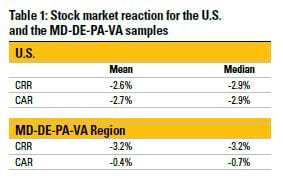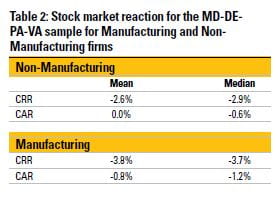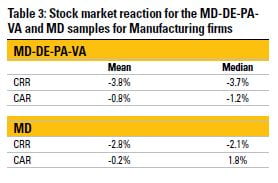Michaël Dewally
Associate Professor, Department of Finance, Towson University
Yingying Shao
Associate Professor, Department of Finance, Towson University
On March 22, 2018, “President Trump put China
squarely in his cross hairs” according to The New York
Times. The White House had just announced tariffs on
$60 billion worth of Chinese goods. The announcement
was part of continued economic tension between the
two nations. The current White House administration
had shifted its stance on economic relations with
China. Rather than encourage trade with China and
rely on China’s efforts to participate in rules-based
agreements, the administration sees its trading partner
as an economic adversary. The decision is a reaction to
questions of fairness of trade with its partner, the U.S.
accusing China of trying to obtain American technology
and trade secrets.
The timing, magnitude and coverage of the tariffs were
unprecedented. This action came at a time when production
sharing across the two countries is at an all-time
high. The market reaction to this escalating trade war
was immediate. We document the varied reactions as
we report the stock price movements for all firms in the
U.S., firms in the Maryland-Delaware-Pennsylvania-
Virginia region and across industries.
The administration had two weeks to reveal the list
of targeted products. The market reaction on these
early days was knee-jerk as the White House had not
sketched out full details of the products that would be
subject to the 25% tariff. The market reacted strongly
negatively. The tension had been building with trade
partners but the White House actions had not targeted
a single trade partner as much up to this point. The
steel and aluminium tariffs announced earlier in March
2018 hit China to a much smaller extent, most of those
tariffs impacting Canada. This new announcement
had the potential to hurt companies for two reasons.
First, firms with suppliers in China would see their
input costs increase as tariffs would raise the prices
of Chinese goods, and would increase the demand for
and the prices of alternate suppliers’ goods. This would
guarantee profit margin pressures for these companies,
if not outright disruption. Second, firms that sell to
China would likely suffer as China was to inevitably
retaliate. The Chinese reaction was in fact immediate
with its own tariffs announcement the following day.

Following the steps of Huang et al. (2020), we focus
our study on the market reaction over the three trading
days surrounding the announcement. We report not
only the 3-day cumulative raw returns (CRR) but also
the market-adjusted cumulative abnormal returns over
the same 3-day window (CAR).
How do stocks of firms in the Maryland-Delaware-Pennsylvania-Virginia region react?
Using data from The Center for Research in Security
Prices, we collect information on all actively traded
firms that are headquartered in Maryland, and the three
states surrounding Maryland. We retrieve information
on 199 firms and proceed to compute the CRRs and
CARs for our sample. We report the results in Table 1.
Table 1 provides summary statistics for CRR and CAR for
the entire U.S. sample of listed firms, excluding financial
firms, as reported in Huang et al. (2020), and the statistics
for the regional sample we created. Overall, the market
reaction to the announcement pushed returns down a
nearly full 3%. The CARs match that number as well.
The distribution is fairly symmetric as Mean and Median
are close to each other. For our regional sample, the raw
reaction is similar to that of the entire nation, showing
a swift negative reaction to the announcement. The
CARs evidence though shows a more muted regional
reaction than nationwide. This evidence requires further
investigation. On the one hand, it hints at a lower reliance
on China for imports and exports. On the other
hand, it highlights smaller headways in trade with the
U.S. largest single-country trading partner. Regardless
of the outlook on the situation, the region’s response
to the announcement was muted.

Observations from the disruption of supply chain from
and potential impairment of sales to China suggest
that firms involved in Manufacturing sectors would
suffer a stronger response to the trade war announcement
than firms in Non-Manufacturing sectors. We
next investigate the causes of the market reaction in
relation to industry distributions. Table 2 splits the
regional sample into two sub-samples. It is clear from
this table that Manufacturing firms suffer the most
from the announcement. Manufacturing firms in the
region experienced an average loss of 3.8% whereas
Non-Manufacturing firms lost only 2.6%. In abnormal
returns term, the Non-Manufacturing sector showed no
reaction (0.0% on average) while the Manufacturing
sector lost 0.8%.
How do stocks of firms in Maryland react?
Were Maryland firms affected differently than their
counterparts in the region? Table 3 reports similar
statistics to the previous tables. In Table 3, we focus
entirely on Manufacturing firms, those firms most affected.
We separate the Maryland group from those
for the entire region. Maryland Manufacturing firms
in general experienced a smaller stock market decline
than firms in the region. The average CAR for Maryland
firms was only -0.2% compared to -0.8% for the region.

Variations nationwide and within the region are certainly
attributable to the distribution of sector activities in
each state. In order to control for these variations in
aggregate, we use Huang et al. (2020)’s methodology
and introduce an industry level measure of Chinese
Import Penetration (IP). Defined as the ratio of Chinese
Imports in the industry to the sum of the industry’s
Shipment Value plus Imports minus its Exports, the
IP measure captures the industry’s “direct trade exposure”
by measuring “the perceived reduction in import
competition from and exports to China.” Huang et
al. (2020) find a positive relationship between IP and
CAR: firms in an industry where Chinese imports are
prevalent will benefit from the enactment of tariffs as
the reduced competition from Chinese products will
boost domestic companies’ profits.
We compute the IP for firms in our sample at the 3-digit
SIC level1. For example, SIC Code 211 for the Cigarettes
industry has a low IP of -0.19 as the industry faces little
competition from Chinese imports. Meanwhile, the IP
of SIC Code 282 for Plastic Materials is a high 0.43
as the industry faces severe competition from Chinese
imports. On balance, given the values in Table 3, we
would expect the aggregate IP of Maryland firms to be
higher than the region’s aggregate IP as the MD CARs
are higher than the region’s. Our computation shows
an IP for the MD firms of 0.09 while the IP for firms in
the other 3 states is 0.12. A further look at the distribution
of Manufacturing in Maryland versus the region
shows that only 3 out of 17 (18%) MD firms have an
IP over 0.1, while, in the rest of the region, 34% (13
out of 38) have an IP in excess of 0.1. That is, firms in
the region are in industries that face more competitive
pressures from Chinese imports. These findings are the
opposite of those from the general regression results
in Huang et al. (2020). This shows that using industry
aggregated levels of exposure to Chinese competition,
while helpful on a large scale, can hide variations within
the industry itself.
Given the limitations of the IP measure exposed above,
we turn to individual stock’s reactions on the day of
the announcement. In particular, we focus on those
firms’ recorded exposure to the Chinese markets. In
Maryland, we contrast the market reactions of U.S.
Silica and W.R. Grace. On the one hand, U.S. Silica had
a +2.2% raw return over the 3-day period. U.S. Silica
does not report any international sales nor international
suppliers in its most recent annual report. The nature
of U.S. Silica’s business leaves the company insulated
from any direct impact from the trade war. On the other
hand, W.R. Grace’s stock price dropped 6.2% over the
same time period. W.R. Grace’s exposure to China is
manyfold. W.R. Grace maintains both production and
credit facilities in China. W.R. Grace’s revenues from
Asia-Pacific represents nearly 25% of its $1.93 billions
in sales for 2018. As such, W.R. Grace was primed to
suffer from the trade war. Universal Security Instruments
is similarly exposed to Chinese imports as it has a joint
venture in Hong Kong supplying it with components.
Universal Security Instruments’s stock price dropped
3.2% on announcement. In the region, United States
Steel in PA experienced the steepest drop of 12%. The
surprise announcement of the new tariffs reiterated the
administration’s resolve in its new trade policies and
dealt a new blow to the steel manufacturer.
More than the direct adverse impact to companies’ stock
prices, the trade war imposed a concern for the State of
Maryland. According to Trade Partnership Worldwide’s
white paper on the projected impact on the U.S. economy
of the trade war, over 800,000 jobs in Maryland are
supported by trade. Of these, 18,800 are threatened
by the trade war. The enacted tariffs impacted 3% of
the Port of Baltimore’s annual tonnage. In December
2018, a survey by the Maryland Chamber of Commerce
revealed that 54% of its members reported that current
trade policies negatively affected their businesses. While
the COVID-19 pandemic has slowed down trade talks
with China, unresolved issues around trade remain a
threat to Maryland businesses.
Reference
1Data source: https://sompks4.github.io/sub_data.html
Landler, Mark and Tankersley, Jim, Trump Hits China with Stiff
Trade Measures (March 22, 2018), The New York Times.
Huang, Yi and Lin, Chen and Liu, Sibo and Tang, Heiwai, Trade
Networks and Firm Value: Evidence from the US-China Trade
War (April 30, 2020). Available at SSRN: https://ssrn.com/
abstract=3227972 or http://dx.doi.org/10.2139/ssrn.3227972
Maryland Chamber of Commerce – https://mdchamber.org/maryland-
chamber-talks-tariffs/
Trade Partnership Worldwide, LLC, Estimated Impacts of Tariffs
on the U.S. Economy and Workers (February 2019), https://
tradepartnership.com/wp-content/uploads/2019/02/All-Tariffs-
Study-FINAL.pdf
